Ah, vacationing with the family. It’s something that often sounds great during the planning process, but the execution leads to mixed results. While we’re still figuring out how to write a guide that gets the family to appreciate the effort you put into planning your vacation, we do cover the things that can help you plan what’s best for your group. Deciding what to do with your precious vacation time can feel overwhelming, so we’ve done all the research and actually lived the experiences we write about. Dining, day trips, hotels, sight seeing and activities are some of our specialties. My guides are the next best thing to having me tagging along in the rental van with you, pointing out the best places to check out while steering you away from the things not worth your time. Here’s my top picks for short hikes around the island of O‘ahu that will feed your explorer’s spirit while burning off the pent up energy from the the long flight over.
First Things First—Gear Up
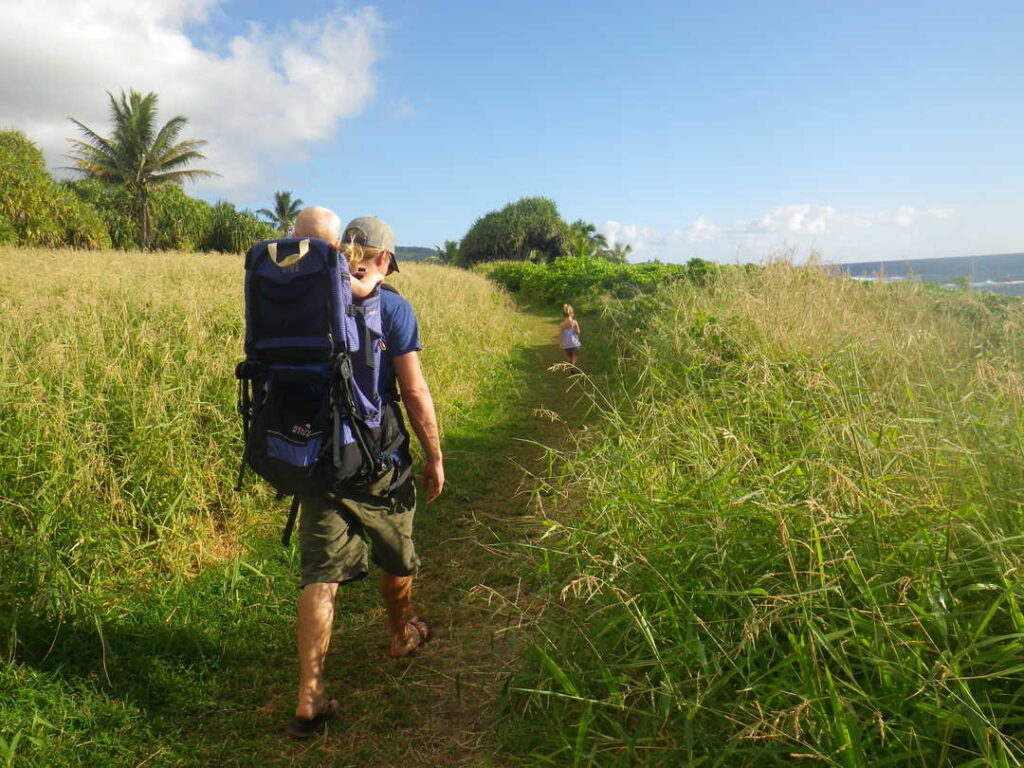
Hawaii is very kid friendly if you know the best places to go, have the right gear, and enjoy the great outdoors. Your kid’s age and your comfort level are the biggest factors to consider when planning your trip. Sun protection is a must (kid-sized UV blocking rashguards and hats) as is having plenty of water. Personal hydration packs (such as CamelBak) are great for hiking and going to the beach. They even come in kids’ sizes (which is nice since you’ll be carrying most everything else). When planning hiking excursions and if your crumb crunchers are age 5 or younger, a baby-frame backpack (like those made by Kelty) is essential. Not only do they keep your keiki (the Hawaiian word for kid) out of harm’s way, but most of these packs also have a surprising amount of room for hauling other gear. Sure, you might look and feel like a pack mule, but sharing the outdoor experience with your little ones is sure to make for lifelong memories. (Plus your kid is already well-positioned for taking selfies with you.) These packs can be checked for free with most airlines since they count as child transport (as do car seats and strollers). Now, onto the hikes…
Diamond Head (2 Miles Round Trip)
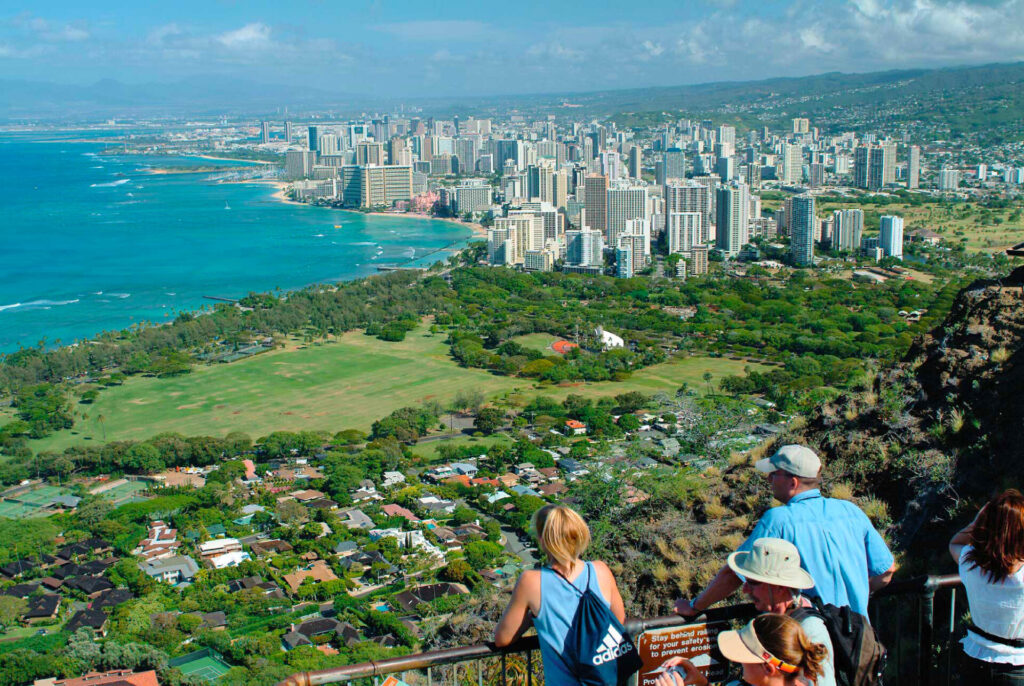 Diamond Head is that iconic volcano crater that defines the Honolulu skyline. And just like the Statue of Liberty in New York, the St. Louis Arch and San Francisco’s Golden Gate Bridge, you’re practically required to visit it.
Diamond Head is that iconic volcano crater that defines the Honolulu skyline. And just like the Statue of Liberty in New York, the St. Louis Arch and San Francisco’s Golden Gate Bridge, you’re practically required to visit it.
On the trail you’ll gain 560 feet over about a mile, and it takes most people about 1.5 hours. That’s 30 to 40 minutes to go up, 20 minutes at the top, then the return. On this trail you’ll see everyone from Ironman triathletes to people literally using walkers (though they probably won’t be hiking the same speed, and the walker users may not go all the way to the top). The trail has sections of unevenness, so wear shoes instead of flip-flops. Short marching steps work best along the constant incline. Near the end, you’ll climb 74 stairs followed by a tunnel, then 99 very steep stairs, plus a spiral staircase, followed by a few more steps. (Ignore advice to bring a flashlight—the interior portions are lit.) If stairs aren’t your thing, there’s a less steep (but longer) paved path to the left after exiting the tunnel.
Visitors from out of state need a reservation in advance from gostateparks.hawaii.gov/diamondhead, and you’ll need parking reservations (which are good for 2 hours) if you’re driving into the crater. It’s $10 per car and $5 per person entrance fee, credit cards only. If the parking lot is full, another option is to park in the small lot on the left, just before the tunnel, and walk the short distance into the crater.
Likeke Falls Hike (Less Than 1 Mile Round Trip)
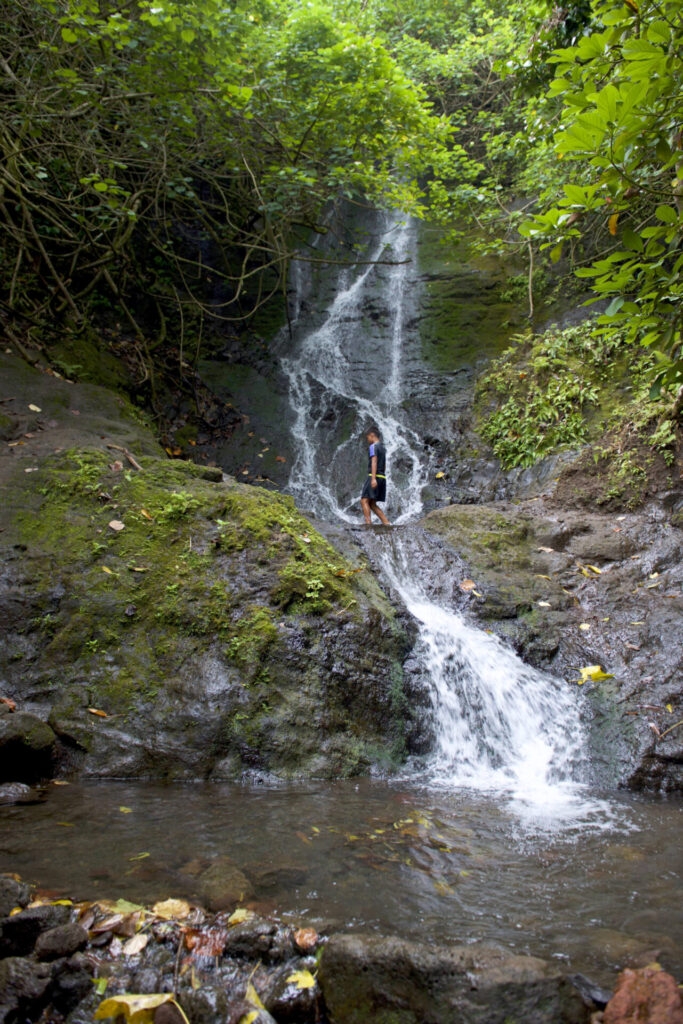 This falls has always been a side trip from the Pali Trail. But some rocks fell on that trail, and the state closed it while they were trying to figure out what to do about them. (Moving the rocks does not appear to have occurred to them yet.) And since reliable waterfalls are hard to come by on O‘ahu, I thought it was important to include this shorter, alternative way to get to them. It’s less than half a mile, and you gain less than 200 feet of elevation. What we like best about Likeke is that even during dry times it flows.
This falls has always been a side trip from the Pali Trail. But some rocks fell on that trail, and the state closed it while they were trying to figure out what to do about them. (Moving the rocks does not appear to have occurred to them yet.) And since reliable waterfalls are hard to come by on O‘ahu, I thought it was important to include this shorter, alternative way to get to them. It’s less than half a mile, and you gain less than 200 feet of elevation. What we like best about Likeke is that even during dry times it flows.
You start in the back of the parking lot of the now closed Ko‘olau Golf Course in Kane‘ohe. (There might be a vehicle chain across the entrance.) You’ll take the trail until it combines with a trail off Auloa-Ki‘ona‘ole Road. Forget what Mama said about looking both ways if you cross this street. It’s been closed since 1994.
The trail goes up and eventually reaches an old stone road. You’re only going up that road for a few minutes when you come to a Y intersection, and you’ll angle back right where the trail takes you to Likeke Falls. It’s about 30 feet high with two small pools below. You can take a cold shower if you climb above the high pool to a ledge under the main stream. If you were to continue down this trail (Likeke Trail), you’d eventually end up near the Likelike Highway (Highway 63), just before the Wilson Tunnel. (I’m only including short hikes with this blog—you won’t want to do the Wilson Tunnel hike.)
To get here from the intersection of the Pali Highway (Highway 61) and Kamehameha (Highway 83) in Kailua, take Kamehameha a short ways until it goes under H-3. Then look for Kionaole Road in the left side and take it to the golf course parking lot. Parking is $10 and closes at 4 p.m.
‘Ohikilolo Point (0.7 Miles Round Trip)
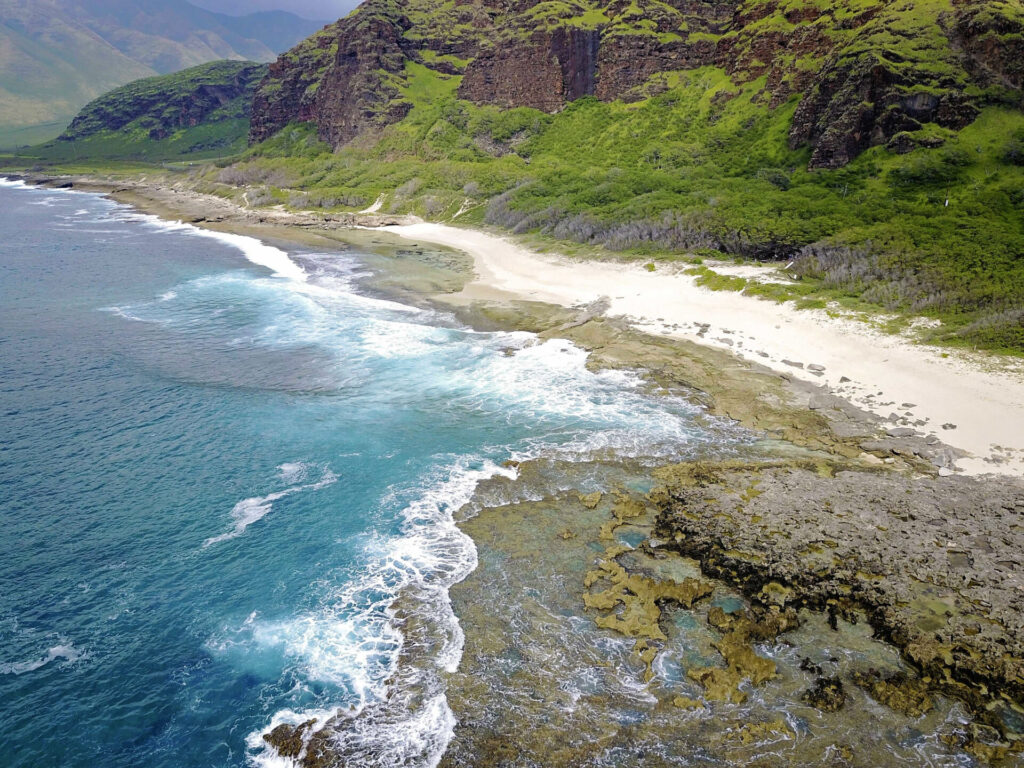 This is a short hike—only 10–15 minutes out to it. But it leads to one of the most interesting lattice-like sandstone benches we’ve seen in Hawai‘i. Once you get to the stony peninsula, walk out as far as the ocean safely allows toward the water. This is all lithified sand, and the ocean is dissolving this former sand dune, creating sharp, awkward footing. Think of it as a large rocky bench that’s been bathed in acid. Many of the places at the outer edge have holes and tiny arches eaten into the sandstone.
This is a short hike—only 10–15 minutes out to it. But it leads to one of the most interesting lattice-like sandstone benches we’ve seen in Hawai‘i. Once you get to the stony peninsula, walk out as far as the ocean safely allows toward the water. This is all lithified sand, and the ocean is dissolving this former sand dune, creating sharp, awkward footing. Think of it as a large rocky bench that’s been bathed in acid. Many of the places at the outer edge have holes and tiny arches eaten into the sandstone.
Farther back you’ll see lots of salt in the depressions. During the winter, giant surf sometimes washes over the entire bench. If that’s the case when you’re visiting, there won’t be much to see here (other than your own demise if you’re foolish enough to walk out onto the bench when it’s being pounded). Those large boulders that lined the trail on your way out were tossed there during such periods, which gives you an idea how strong the surf can be at times.
To get here, drive to Wai‘anae to near the end of the road. After mile marker 17 is Makua Cave on the right. Park across the street from the cave, and take the trail on the left toward the shoreline, then walk left along the shore. The point is just after ‘Ohikilolo Beach. Don’t leave anything valuable in your car here.
Manoa Falls (2 Miles Round Trip)
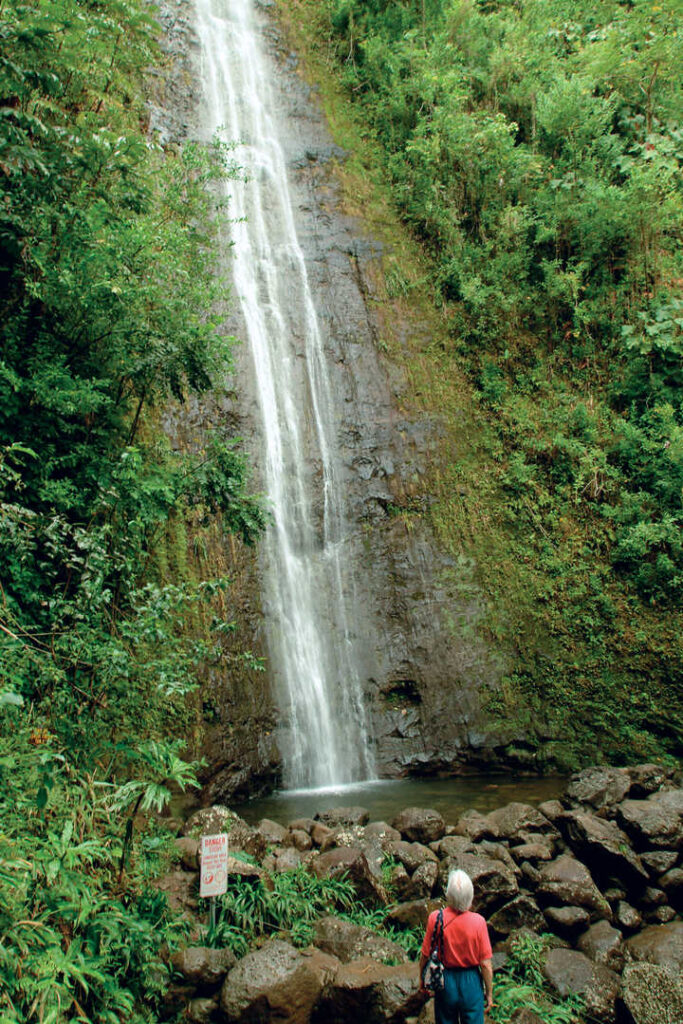
This is generally considered the second most popular hike on the island (after Diamond Head), but I haven’t seen nearly as many people on it as its reputation suggests. It’s popular for good reason. The trail is close to Honolulu, but the isolated jungle valley is a world away from the city noise. The surrounding forest is staggeringly beautiful. It’s only a mile each way (though you gain 800 feet in the process), and it rewards you with a very pretty 160-foot-high waterfall.
Right from the get-go, it’s obvious that this is an impossibly lush area. Giant trees with luxuriant clinging vines, elephant-eared ape (pronounced ah-pay) plants and every shade of green you could want along with a soundtrack of tropical birds create an Eden-like atmosphere. The stream is always nearby, and the verdant growth is ever present. Once at the falls, there’s a bench to sit on and listen to the hissing water. All in all, a very rewarding hike for relatively little effort.
To get there, either take McCully out of Waikiki, past H-1 and onto Metcalf, then left on University Avenue, or if you’re on H-1, take the University Avenue exit (24B) and head mauka (a Hawaiian term for “toward the mountains”). University Avenue will become O‘ahu Avenue. Then take the right fork—not the right turn—at a confusing five-way intersection onto Manoa Road and drive until you see a paid parking lot ($5). Bring mosquito repellent. The trail is mostly well maintained and much of it is lined with gravel, but expect muddiness—possibly a lot of muddiness—if it’s been raining lately. (Which it probably has—that’s why it’s so lush here.)
Land Tours
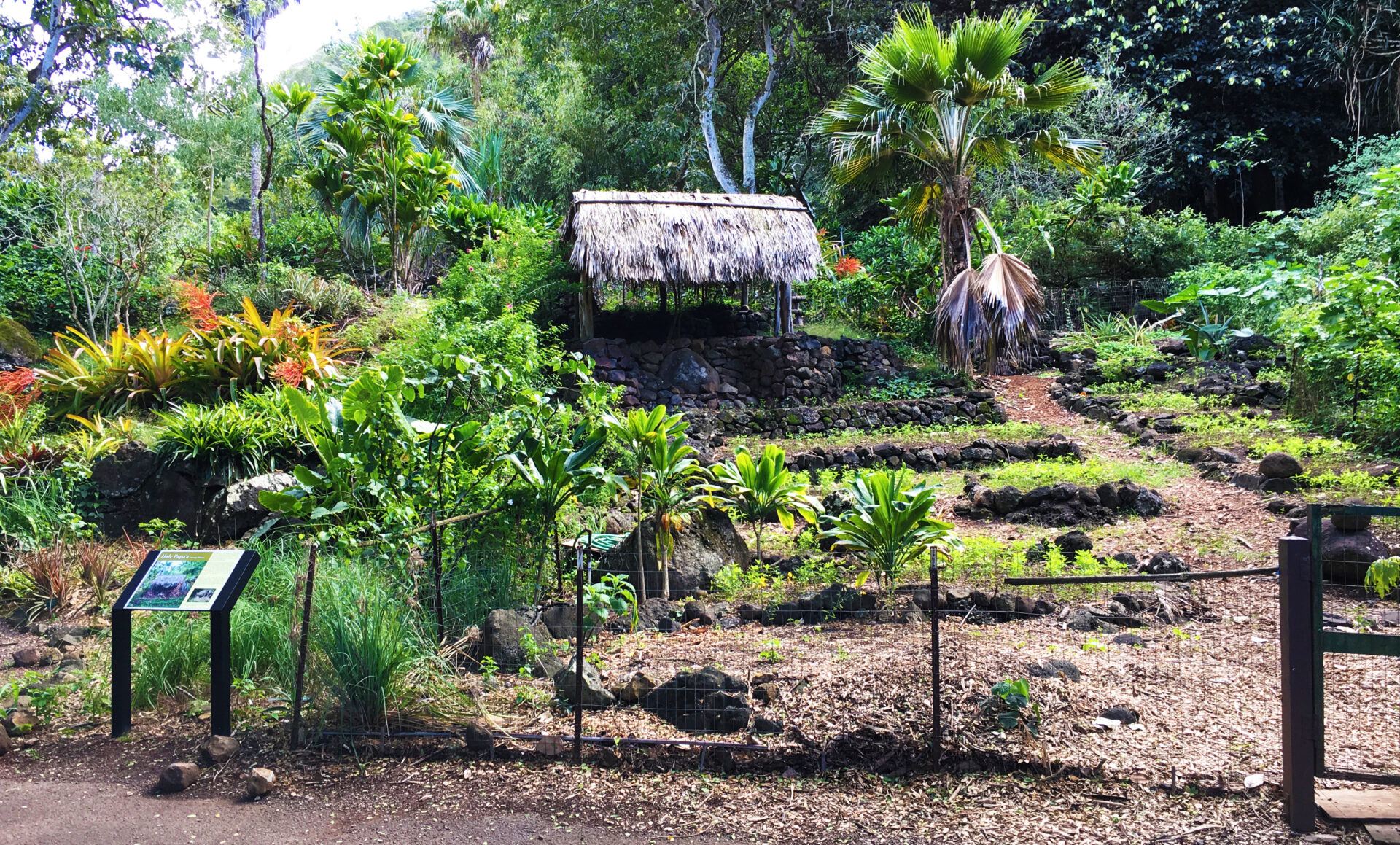
Waimea Valley: General Admission
Waimea Valley, previously known as Waimea Falls Adventure Park, is now a botanical garden managed by the Office of Hawaiian Affairs. This 1,875-acre garden features a tranquil setting along the Waimea River and a 40-foot-high waterfall.
There’s so much to see and do across Hawaii. Researching what you can do and where to find things can put a real drag on your time. Revealed Travel Guides have done the research for you, and present your options in a candid way that makes vacation planning a breeze. Check out our believable guides for unbelievable vacations.
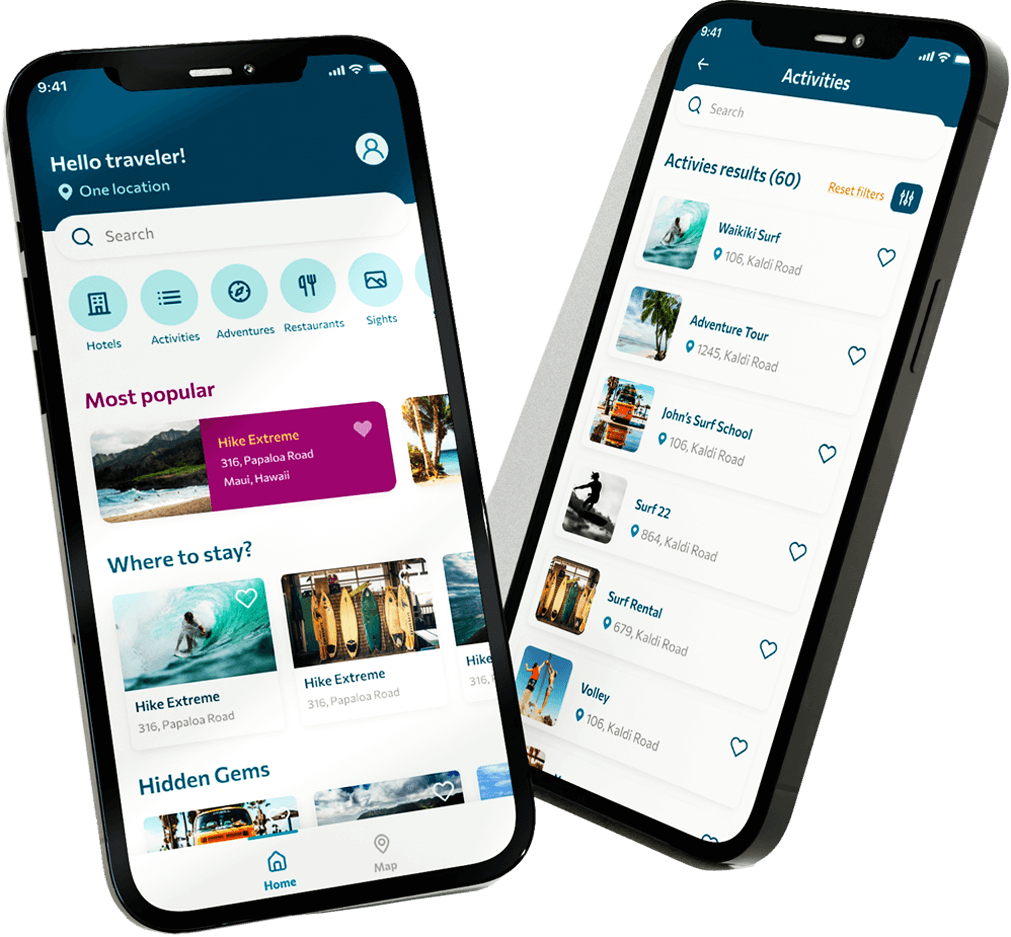



0 Comments